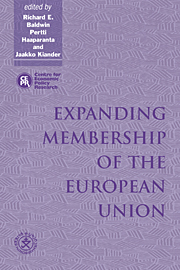Book contents
- Frontmatter
- Contents
- List of figures
- List of tables
- Preface
- Acknowledgements
- List of conference participants
- 1 Introduction
- PART ONE THEORETICAL ISSUES
- PART TWO POLICY ISSUES
- 5 Voting power and control in the EU: the impact of the EFTA entrants
- 6 Migration in the integrated EU
- 7 Trade effects of regional aid
- PART THREE EMPIRICAL ISSUES
- Index
6 - Migration in the integrated EU
Published online by Cambridge University Press: 05 November 2011
- Frontmatter
- Contents
- List of figures
- List of tables
- Preface
- Acknowledgements
- List of conference participants
- 1 Introduction
- PART ONE THEORETICAL ISSUES
- PART TWO POLICY ISSUES
- 5 Voting power and control in the EU: the impact of the EFTA entrants
- 6 Migration in the integrated EU
- 7 Trade effects of regional aid
- PART THREE EMPIRICAL ISSUES
- Index
Summary
Introduction
Very few issues can stir controversies and arouse divisive passions as much as migrations. The literature on the topic is enormous. It has attracted contributions from all the fields of social science, including economics. Seldom, however, is the economist's assessment of an issue so much at odds with the common perception of the problem. Economists typically argue that free labour movement is conducive to economic efficiency. Existing barriers to labour mobility are responsible for a substantial loss in world-wide GDP (Hamilton and Whalley, 1984). However, the call for free labour mobility falls on deaf ears among policy makers. In 1990, a French Minister, addressing his national Parliament, pleaded for the maintenance of border controls within the EU, citing migrations as one of the main unresolved issues.
This chapter tries to assess the outlook for migrations in the EU. It makes four points: (1) Even the full abolition of intra-EU border controls will not lead to a significant expansion of migrations by EU residents. In the past, Southern European countries used to be the prominent source of migrant labour for Northern European markets. Today, there is mounting evidence pointing to a dramatic fall in the propensity to migrate from Southern European countries. (2) The presence of a large number of (often illegal) non-EU migrants in many European countries, particularly in Southern Europe, is often cited as a reason for concern.
- Type
- Chapter
- Information
- Expanding Membership of the European Union , pp. 143 - 165Publisher: Cambridge University PressPrint publication year: 1995
- 3
- Cited by

